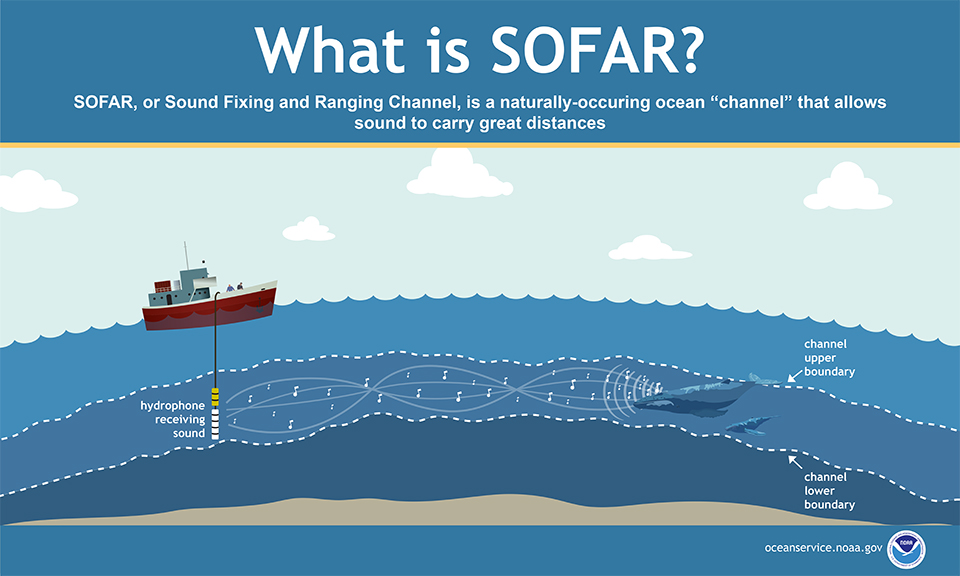What is SOFAR?
SOFAR is an ocean “channel” that allows sound to carry great distances.

The ocean consists of many zones. Sound can travel through a zone for hundreds, sometimes thousands of miles. Download Infographic | Infographic Text
At the height of World War II, scientists tested a theory that low-frequency sound could travel long distances in the deep ocean. They deployed a hydrophone from their research vessel, which was anchored off of Woods Hole, Massachusetts. Some 900 miles away, another ship lowered a four-pound explosive to a specific depth below the ocean surface. Once detonated, the explosion propelled pulses of sound that traveled the 900 hundred miles from one ship to the other. That’s nearly the distance from Washington, DC, to Des Moines, Iowa!
For the first time, researchers heard what they termed SOFAR, or a SOund Fixing And Ranging transmission. As the scientists noted, “The end of the sound channel transmission was so sharp that it was impossible for the most unskilled observer to miss it.”
How does SOFAR work? Think of the ocean as consisting of various zones, or layers — sort of like oil and vinegar salad dressing before it’s shaken up — except that ocean layers occur due to differences in salinity (salt content) and temperature variations. Saltier and colder water lie beneath less salty, warmer water.
Because of SOFAR, sound emitted at a certain depth bounces between these various layers and can travel for hundreds of miles. This up-and-down bending of low-frequency soundwaves allows soundwaves to travel great distances without the signal losing significant energy. By placing hydrophones at the axis of the sound channel, researchers can record sounds such as whale calls, earthquakes, and manmade noise occurring vast distances from the hydrophones. In some instances, low-frequency sounds can be heard across entire ocean basins.
Infographic Text
What is SOFAR?
This infographic illustrates how SOFAR works. It shows a ship with a deployed underwater hydrophone receiving the sounds of distant whales, thanks to the effects of the SOFAR channel.
SOFAR, or Sound Fixing and Ranging Channel, is a naturally-occurring ocean "channel" that allows sound to carry great distances.
Search Our Facts
Get Social
More Information
Did you know?
Whales tuned into the SOFAR channel long before scientists. As whales migrate, they rely on SOFAR to communicate over distances of hundreds and even thousands of miles. Ship traffic and other human activities result in a noisier ocean, though—and studies show that louder noise levels interfere with whale communication. This “cocktail party effect” impedes many marine animals that depend on sound for their most basic needs, including food, communication, protection, reproduction, and navigation.

Last updated: 06/16/24
Author: NOAA
How to cite this article